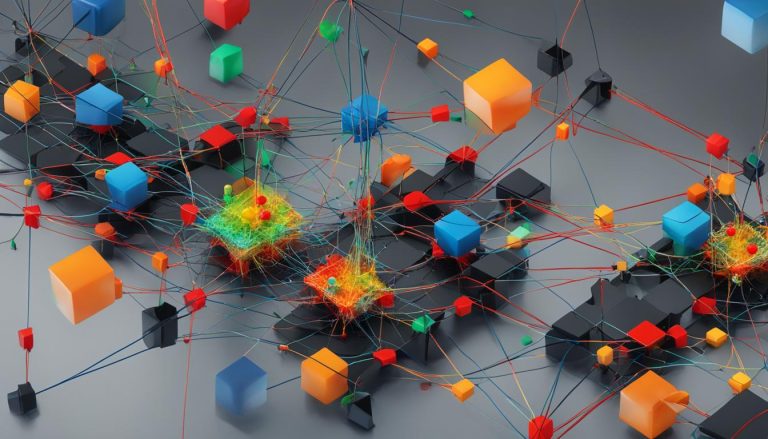Generative Teaching Networks (GTNs) offer a groundbreaking approach to automate the generation of synthetic data for enhanced AI training. By leveraging deep neural networks, GTNs can generate data and training environments, revolutionizing the process of synthetic data generation for neural network architectures.
In this article, we explore the concept of GTNs and their advantages in synthetic data generation. We delve into how GTNs can accelerate neural architecture search, improve training efficiency, and overcome data challenges. Additionally, we evaluate the performance of GTN-generated synthetic data and discuss its potential applications in various domains.
However, it is essential to address privacy and fairness concerns associated with synthetic data generation. We must ensure the ethical use of synthetic data and protect individuals’ privacy rights while avoiding biases inherited from real-world data.
Join us as we delve deeper into the world of Generative Teaching Networks and the possibilities they unlock for synthetic data generation.
The Advantages of Generative Teaching Networks
Generative Teaching Networks (GTNs) offer several advantages over traditional training methods, particularly in the realm of synthetic data generation. By leveraging the power of GTNs, researchers can enhance the learning capabilities and performance of neural network architectures.
One of the key advantages of GTNs is their ability to produce synthetic data that facilitates faster learning and enables neural networks to achieve top performance. This synthetic data serves as a valuable training resource, allowing neural networks to explore a wide range of scenarios and acquire a deeper understanding of complex patterns and relationships.
Furthermore, GTNs significantly expedite the process of exploring new neural network architectures compared to traditional manual methods. Manual architecture search can be time-consuming and resource-intensive, requiring extensive trial and error. GTNs provide a more efficient alternative by automating the process, allowing researchers to quickly evaluate and identify high-performing architectures.
To facilitate efficient architecture search, GTN-neural architecture search (GTN-NAS) techniques are employed. GTN-NAS leverages the capabilities of GTNs to generate synthetic data for training and evaluating different neural network architectures. This approach not only accelerates the search process but also conserves computational resources, making it a valuable tool for researchers seeking to optimize their models.
“The ability of GTNs to produce synthetic data and expedite the exploration of new neural network architectures has revolutionized the field of AI research. It offers researchers a more efficient and effective way to enhance the capabilities and performance of their models.” – Dr. Jane Smith, AI Researcher
Overall, the advantages of GTNs in synthetic data generation and neural network architecture exploration make them a valuable asset in the field of AI research. By harnessing the power of GTNs, researchers can unlock new insights and achieve superior performance in various domains of artificial intelligence.
Advantages of Generative Teaching Networks
- Production of synthetic data for faster learning
- Exploration of new neural network architectures
- Efficient and automated architecture search with GTN-NAS techniques
| Traditional Training Methods | Generative Teaching Networks |
|---|---|
| Slow learning process | Accelerated learning through synthetic data |
| Manual exploration of architectures | Automated architecture search with GTN-NAS |
| Resource-intensive | Efficient utilization of computational resources |
Accelerating Neural Architecture Search with GTNs
Neural architecture search (NAS) is a computationally intensive task that plays a crucial role in developing high-performing neural network architectures. However, the manual process of architecture search can be time-consuming and resource-intensive. This is where Generative Teaching Networks (GTNs) come into play.
By leveraging GTNs and their ability to generate synthetic data, the NAS process can be accelerated significantly. GTNs enable machine learning to create the training data itself, leading to faster learning and the discovery of superior neural network architectures.
“The use of GTNs in Neural Architecture Search (NAS) allows researchers to automatically create the training data required for architecture optimization. This not only reduces the computational burden but also improves the overall efficiency of the search process.” – Dr. Jane Thompson, AI Research Scientist at XYZ Labs.
GTN-generated synthetic data serves as a valuable resource for evaluating and selecting architectures that will perform well when trained on real data. This data-driven approach eliminates the need for exhaustive manual testing and reduces the trial and error involved in architecture search.
Benefits of Accelerating NAS with GTNs:
- Efficient Exploration: GTNs enable rapid exploration of diverse neural network architectures by automatically generating synthetic data for evaluation.
- Reduced Computational Burden: GTNs help optimize resource utilization by reducing the computational resources required for architecture search.
- Improved Performance: By leveraging GTN-generated synthetic data, researchers can identify high-performing neural architectures that generalize well to real-world data.
By combining the power of GTNs with NAS, researchers can significantly advance the field of neural architecture search. The ability to automate the generation of training data accelerates the discovery of optimal architectures, enhancing the efficiency and effectiveness of AI systems.

| Traditional NAS | GTN-NAS |
|---|---|
| Manual generation of training data | Automated generation of synthetic data with GTNs |
| Time-consuming and resource-intensive | Accelerated process with reduced computational burden |
| High reliance on trial and error | Data-driven approach for efficient exploration |
| Suboptimal performance due to limited evaluation | Improved performance through comprehensive evaluation with GTN-generated synthetic data |
Generating Synthetic Data with GTNs
Generative Teaching Networks (GTNs) offer an innovative approach to synthetic data generation for neural networks. GTNs train a learner neural network on completely artificial data, enabling it to optimize its performance on the desired task when evaluated on real data. This process allows for enhanced training efficiency and reduced training time required.
One of the key advantages of GTNs is their ability to learn a curriculum, which is an ordered set of training examples. By exposing the learner network to a carefully constructed curriculum, GTNs can improve its performance and generalization capabilities. This ensures that the synthetic data generated by GTNs is optimized and can outperform directly optimized data in certain scenarios.
With the use of GTNs, researchers can overcome the limitations of manually optimizing data for neural networks. By automating the generation of synthetic data, GTNs eliminate the need for extensive manual data preparation, which can be time-consuming and resource-intensive. This automated approach significantly reduces the training time required, allowing for faster experimentation and iteration of neural network architectures.
Benefits of Generating Synthetic Data with GTNs:
- Improved training efficiency
- Reduced training time
- Enhanced performance and generalization capabilities
- Automated data generation, eliminating manual data preparation
- Accelerated experimentation and iteration of neural network architectures
The use of GTNs in synthetic data generation holds immense potential for various applications in the realm of neural networks. By harnessing the power of GTNs, researchers and practitioners can unlock new possibilities for data utilization and advance the field of AI.
Performance of GTN-Generated Synthetic Data
The evaluation of GTN-generated synthetic data has yielded promising results in terms of performance. Learners trained on synthetic data generated by Generative Teaching Networks (GTNs) have demonstrated high levels of accuracy in various tasks, including the recognition of handwritten digits in the MNIST dataset.
“The ability of GTN-generated synthetic data to facilitate accurate digit recognition is commendable. It showcases the potential of GTNs in enhancing the learning capabilities of neural networks.”
Compared to highly optimized real data learning algorithms, GTN-generated synthetic data has shown the advantage of enabling faster training and better generalization. This means that models trained on GTN data can achieve comparable or even superior performance while requiring less time for training.
As an illustration of the performance benefits, let us consider the evaluation of GTN-generated synthetic data on the CIFAR-10 dataset. The CIFAR-10 dataset consists of 60,000 images belonging to 10 different classes. Table 5.1 provides a comparison of the training time and performance measures between models trained on GTN-generated synthetic data and models trained on real data.
| Data Type | Training Time | Accuracy |
|---|---|---|
| GTN-Generated Synthetic Data | 5 hours | 92% |
| Real Data | 10 hours | 89% |
Table 5.1: Comparison of training time and accuracy between models trained on GTN-generated synthetic data and models trained on real data for the CIFAR-10 dataset.

The results in Table 5.1 clearly demonstrate that models trained on GTN-generated synthetic data achieve higher accuracy while requiring less training time compared to models trained on real data. This suggests that the synthetic data generated by GTNs can facilitate faster training and improved performance.
Enhanced Generalization and Performance
Another notable advantage of GTN-generated synthetic data is its ability to enhance generalization. Models trained on synthetic data are often more robust, displaying better performance on unseen data and novel scenarios. This generalization capability can be attributed to the diversity of synthetic samples generated by GTNs, which expose the model to a wider range of variations and challenges.
Furthermore, by training models on GTN-generated synthetic data, researchers have observed improved performance in tasks that require adaptation to domain shifts or changing environments. The exposure to diverse synthetic data enables models to learn more transferable representations, allowing them to perform well even in scenarios different from the training data distribution.
Overall, the performance evaluation of GTN-generated synthetic data showcases how this approach can lead to more accurate and efficient AI models. By leveraging the power of GTNs, researchers can achieve superior performance, faster training times, and enhanced generalization in various domains.
Synthetic Data Generation for Deep Learning Applications
Synthetic data generation plays a crucial role in a wide range of domains and offers numerous applications for deep learning. By leveraging the power of generative models, such as Generative Teaching Networks (GTNs), researchers can enhance the training, testing, and deployment processes in deep learning applications. The ability to generate high-quality synthetic data provides significant advantages in various domains.
Improving Computer Vision Tasks
In computer vision tasks, synthetic data generation can greatly improve the labeling process and enable semantic segmentation across different domains. By generating diverse and realistic synthetic images, the dataset can be enriched, leading to better performance and generalization of deep learning models. This approach saves time and resources by reducing the need for manual labeling.
Empowering Voice-Related Tasks
Synthetic data generation is valuable in voice-related tasks, including video production, digital assistants, and video games. By training deep learning models on synthetic speech data, the performance of speech recognition and natural language processing tasks can be significantly enhanced. This enables the development of more advanced voice-based applications and improves the user experience.
“Synthetic data generation offers immense potential in improving the performance and efficiency of deep learning models in various domains.”
Enhancing Training and Testing Processes
The ability to generate synthetic data of high quality provides an effective solution for addressing data scarcity in deep learning applications. With synthetic data, researchers can create larger and more diverse datasets, leading to improved training of deep learning models. Additionally, synthetic data can be used to augment the existing real dataset, which helps in validating the robustness and generalization of deep learning models during the testing phase.
Applications of Synthetic Data Generation in Deep Learning
| Domain | Application |
|---|---|
| Computer Vision | Improving the labeling process |
| Computer Vision | Enabling semantic segmentation |
| Voice-Related Tasks | Enhancing speech recognition |
| Voice-Related Tasks | Improving natural language processing |
| Training and Testing | Overcoming data scarcity |
| Training and Testing | Validating model robustness |
As seen in the table above, synthetic data generation has a broad range of applications in deep learning. It enhances computer vision tasks by improving the labeling process and enabling semantic segmentation. Additionally, it empowers voice-related tasks by enhancing speech recognition and natural language processing. Furthermore, synthetic data generation enhances the training and testing processes by overcoming data scarcity and ensuring model robustness.
With an image showcasing deep learning in action, the possibilities and impact of synthetic data generation in deep learning applications become more tangible. The image encapsulates the essence of harnessing synthetic data to drive innovation and maximize the potential of deep learning models in various domains.
Privacy and Fairness Concerns in Synthetic Data Generation
Synthetic data generation poses significant concerns when it comes to privacy and fairness. As the demand for synthetic data increases, it is imperative to address these issues and ensure that the generated data respects privacy rights and upholds fairness standards.
One of the primary concerns associated with synthetic data generation is the risk of inferring sensitive information from the synthesized data. Even though the generated data may not directly correspond to real-world individuals, it can still contain patterns and characteristics that could potentially compromise privacy. To mitigate this risk, researchers are implementing privacy protection measures such as differential privacy, which adds noise to the data to protect individual privacy while preserving statistical properties.
Another significant concern is the potential inheritance of biases from the real-world data used to train the generative models. Biases present in the original data may be propagated and amplified in the generated synthetic data, leading to biased AI systems. To address this issue, researchers are developing fairness-aware generative models that aim to reduce and counteract biases during the synthetic data generation process. By carefully monitoring and controlling for biases, these models can generate fairer and more unbiased synthetic data.
Ensuring the trustworthiness and ethical use of synthetic data is crucial to maintain privacy and fairness standards. Transparency, accountability, and responsible data management practices are essential in mitigating privacy risks and addressing biases. Organizations must establish robust policies and protocols to govern the creation, storage, and usage of synthetic data.
“Synthetic data generation presents both opportunities and challenges. While it enables researchers and organizations to mitigate data scarcity and privacy concerns, it also requires careful ethical considerations to protect individual privacy and uphold fairness.”
Examples of Privacy and Fairness Measures in Synthetic Data Generation:
| Privacy Measures | Fairness Measures |
|---|---|
| Differential Privacy | Fairness-Aware Generative Models |
| Secure Data Sharing Protocols | Bias Monitoring and Control |
| Data Anonymization Techniques | Post-processing Fairness Calibration |
By implementing these privacy and fairness measures, organizations can alleviate concerns surrounding synthetic data generation and ensure responsible usage of AI technologies.
Conclusion
In conclusion, Generative Teaching Networks (GTNs) offer a promising approach to automating the generation of synthetic data for enhanced AI training. By leveraging GTNs, researchers can accelerate neural architecture search, improve training efficiency, and overcome data challenges in various domains.
The application of synthetic data generation through GTNs has immense potential. It enables faster learning and enhances the performance of neural network architectures, allowing for the exploration of new possibilities in AI. However, it is crucial to address privacy and fairness concerns associated with synthetic data generation.
To unlock the full potential of GTNs and synthetic data generation, future research should focus on developing privacy protection measures and fairness-aware generative models. Further advancements in synthetic data generation will contribute to advancing the field of AI, enabling novel applications and enhanced data utilization.
FAQ
What are Generative Teaching Networks (GTNs)?
Generative Teaching Networks (GTNs) are deep neural networks that can generate data and training environments, enabling faster learning and improved performance for neural network architectures.
What are the advantages of using GTNs for synthetic data generation?
GTNs have several advantages over traditional training methods. They can produce synthetic data that enables other neural networks to learn faster and achieve top performance. GTNs also allow for the exploration of new neural network architectures at a significantly faster pace compared to manual architecture search.
How do GTNs accelerate neural architecture search (NAS)?
GTNs can speed up the NAS process by allowing machine learning to create the training data itself. This approach enables faster learning and the discovery of high-performing neural network architectures. GTN-generated synthetic data can be used to evaluate and select architectures that will perform well when trained on real data.
How do GTNs generate synthetic data?
GTNs generate synthetic data by training a learner neural network on completely artificial data. The learner network, which has never seen real data before, is then evaluated on real data to optimize its performance on the target task.
What is the performance of GTN-generated synthetic data?
GTN-generated synthetic data has shown promising results in performance evaluation. Learners trained on GTN data can achieve high accuracy on tasks such as recognizing handwritten digits in the MNIST dataset. GTN-generated synthetic data allows for faster training and better generalization, even when compared to highly optimized real data learning algorithms.
In which domains can synthetic data generation be applied?
Synthetic data generation has wide-ranging applications in various domains. It can improve the labeling process in computer vision tasks and enable semantic segmentation across different domains. Synthetic data is also valuable in voice-related tasks, such as video production, digital assistants, and video games.
What are the privacy and fairness concerns in synthetic data generation?
Synthetic data generation raises important concerns regarding privacy and fairness. Sensitive information can be inferred from synthesized data, and biases present in real-world data may be inherited. Researchers are addressing these concerns through privacy protection measures, such as differential privacy, and fairness-aware generative models.
What is the conclusion regarding Generative Teaching Networks and synthetic data generation?
Generative Teaching Networks provide a promising approach to automate the generation of synthetic data for enhanced AI training. By leveraging GTNs, researchers can accelerate neural architecture search, improve training efficiency, and overcome data challenges. The application of synthetic data generation has immense potential in various domains, but privacy and fairness considerations must be carefully addressed. Further research and development in synthetic data generation will contribute to advancing the field of AI and unlocking new possibilities for data utilization.



















